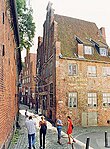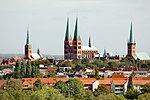Stadion Lohmühle
The Lohmühle – officially the Dietmar-Scholze-Stadion an der Lohmühle as of the 2020-21 3. Liga season - is a football stadium in Lübeck, Germany. It is the home ground of VfB Lübeck, located in the Holstentor Nord district, which is itself part of the larger St. Lorenz Nord area of the city. After the demolition of the old terracing and construction of the new main stand in 1996, a consequence of the club’s promotion to the 2. Bundesliga the previous year, the stadium now has a capacity of 17,849 seats, of which about 4,400 are covered. For a considerable period prior to the redevelopment of Kiel’s 15,034-seater Holstein-Stadion, the Lohmühle was the largest stadium in Schleswig-Holstein, but due to various restrictions (including fire safety and the requirement for TV and media areas) only around 10,800 seats are currently usable. Between November 2011 and 2013 it was called PokerStars.de – Stadion an der Lohmühle because of a naming rights sponsorship by PokerStars.de.
Excerpt from the Wikipedia article Stadion Lohmühle (License: CC BY-SA 3.0, Authors).Stadion Lohmühle
Bei der Lohmühle, Lübeck Sankt Lorenz Nord (Sankt Lorenz Nord)
Geographical coordinates (GPS) Address External links Nearby Places Show on map
Geographical coordinates (GPS)
| Latitude | Longitude |
|---|---|
| N 53.881111111111 ° | E 10.668888888889 ° |
Address
Stadion Lohmühle
Bei der Lohmühle 13
23554 Lübeck, Sankt Lorenz Nord (Sankt Lorenz Nord)
Schleswig-Holstein, Germany
Open on Google Maps










